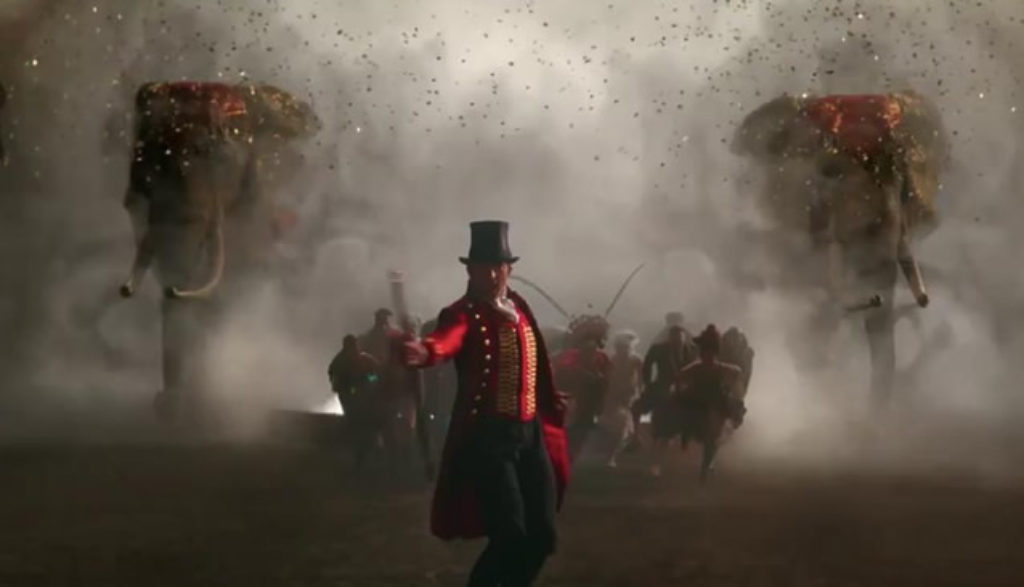
Lions and tigers and bears, oh my!
Well, take out the lions, tigers and bears, then and add an elephant, an unlikely gang of misfits and a ring master and you’ve got … the circus. But a circus isn’t born overnight. An no one knows that better than Phineas Taylor Barnum, better known as P.T. Barnum.
Born into poverty and the son of a tailor, Barnum has a lot on his plate. He must grapple with the death of his father, the disdain of his father-in-law and the ongoing demands of providing for his family.
But he’s determined to prove himself to them—and to the world. And that means thinking outside the box.
What one person might consider a calamity, for instance, Barnum views as an opportunity. After he’s laid off from his job, Barnum opens a museum. Not just any ol’ museum, mind you. This one specializes in wax figures, preserved rarities and all things … odd. Still, Barnum’s daughters think it needs something with even more ticket-selling pizzazz—something alive and human. Like, say, a bearded woman. Or a brother-sister trapeze duo. Or a grown man who’s just a few feet tall.
According to Barnum, “a man’s station is limited only to his imagination.” So imagine he does.
But while the showman’s family and his newfound performers benefit from his creativity, not everyone is enthralled with his idea of a “circus.” Some of Barnum’s critics deride it as a “freak show.”
Will Barnum persevere in pursuing his eccentric-but-engaging vision of entertainment? Or will his rising fame and fortune blind the natural-born promoter to what truly matters in life? The Greatest Showman unpacks the answers to those questions in a musical that invites audiences to step behind the curtain of P.T. Barnum’s remarkable life.
The Greatest Showman explores the twin factors that propelled P.T. Barnum to success: his need to provide for his family combined with his need to find a greater purpose in life. Along the way, Barnum becomes a hero of sorts—a hero who experiences the highs and lows that dreaming big inevitably creates. Amid his growing success, though, Barnum is dedicated to the happiness of his family. He vows to place them first as he ventures into the unknown, where things aren’t as easy as they may seem.
“We can live in a world we design,” Barnum tells his family at one point. So design they do. In the process, they recruit the outcasts of society and work hard to give them a place where they feel value—often for the first time in their lives—even though their lives are still quite difficult.
Barnum models unconditional acceptance for some who’ve been disowned even by their own families. He accepts them despite their differences in a world that, he says, may “never stop judging.” He hires people of all shapes, sizes, classes and races, and there is a sense that a “celebration of humanity” exists within the circus troupe he cultivates. A family, if you will.
Along the way, one character is inspired to pursue a mixed-race romance (in the face of sharp criticism from his family), even though it was culturally unheard of at the time. And Barnum—ever the vision-caster—tells his circus performers repeatedly that “[critics] don’t understand, but they will.”
Barnum increasingly faces the various pressures of the entertainment industry, as well as scandals that threaten to ruin his creative enterprise. But he vows that his “eyes won’t be blinded by the light.” And indeed, messages about the importance of fidelity and family resonate throughout the film.
Barnum gives his daughters a “wishing machine,” which he says will make their dreams come true. (Of course, he’s the one who works hard to fulfill their every desire.)
Angry members of the Catholic Legion of Decency protest the circus.
Phillip and Anne (the mixed-race couple mentioned above) sing a song that includes some lyrics that are mildly suggestive: “You know I want you/ … I know you want me/ … But I can’t have you.” We see the pair swing together, intertwined, on the end of a rope. After a fall, Anne rolls on top of Phillip. They briefly hold hands and kiss in two scenes. Likewise, P.T. Barnum repeatedly kisses his wife, Charity.
Another female character tries to seduce Barnum, but he declines her advances. Later, she kisses him unexpectedly onstage, resulting in a scandal.
Women in the circus crew often wear tight, burlesque outfits (lace and garter belt stockings) that reveal their upper thighs and cleavage.
Young P.T. Barnum is slapped, pushed and hit. Two circus members brawl with unruly men who are shouting names at them. We also see a fire (that’s set on purpose), as well as several characters bravely trying to rescue others from it.
We hear the word “d–n” in two songs. As mentioned, circus members are repeatedly derided as “freaks.”
Characters (including Barnum) down beer, champagne and shots of hard liquor. In one particular scene, Barnum and another character knock back enough shots to seemingly raise their blood alcohol level well beyond legal or safe limits.
Barnum is orphaned after his father’s death, a fate that leads him to steal bread to survive. As an adult, Barnum lies at one point (though, admittedly, in the service of trying to provide for his family).
As Barnum’s popularity increases and his ambitions grow ever larger, he takes off across the United States, leaving his family and his crew behind. He lives lavishly. In one scene where he’s trying to impress some well-to-do patrons, he treats his crew cruelly. His wife misses “the man I fell in love with,” and his young daughters live for a time without their father’s presence in their lives. Barnum’s self-focused choices nearly cost him his marriage, but that conflict is resolved by film’s end.
Hugh Jackman, who stars as P.T. Barnum here, recently compared the iconic character he portrays to “Elon Musk or Steve Jobs.” Like those men, Barnum was truly an innovator. He constantly challenged the rules of traditional society, creating an unprecedented world of wonder as he invited audiences to gaze into the great and the unknown, the majestic and the mysterious. “Comfort,” he opined, was “the enemy of progress.”
Barnum’s extravagant circus performances appealed to huge audiences. But those shows also generated criticism from some who felt the great showman’s work was nothing but an immoral spectacle. The Greatest Showman paints a portrait of the metaphorical tightrope P.T. Barnum walked, and we’re drawn into his mesmerizing world where dreams take flight. There, all individuals have value, family is esteemed highly, and fidelity is shown to be the bedrock of marriage.
It’s a place where you feel as if anything is possible, that any dreamer can conquer the world. You might even stand to leave with a feeling of true joy thinking, as did Barnum, “The greatest art is of making others happy.”

Kristin Smith joined the Plugged In team in 2017. Formerly a Spanish and English teacher, Kristin loves reading literature and eating authentic Mexican tacos. She and her husband, Eddy, love raising their children Judah and Selah. Kristin also has a deep affection for coffee, music, her dog (Cali) and cat (Aslan).